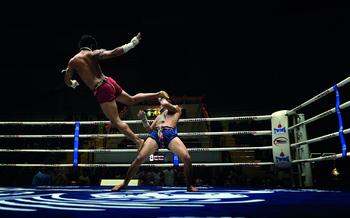
Khao Lak Thai Boxing Classes
- Khao Lak Thai Boxing Classes: An Overview
- Choosing the Right Gym
- Essential Gear
- Warm-up Exercises
- Significance of Warming Up
- Typical Warm-up Routine
- Basic Techniques:
- Pad Work: Sharpening Skills and Conditioning
- Clinch Work: Mastering Close-Range Combat
- Grading System: A Testament to Skill and Dedication
- Fitness Benefits
- Cultural Experience
- Safety Precautions
- Progress Tracking
- Insider Tip: Local Cuisine:
Khao Lak Thai Boxing Classes: An Overview
In the heart of Khao Lak, a vibrant coastal town in southern Thailand, lies a rich tradition of Thai boxing, also known as Muay Thai. This ancient martial art, with its roots in self-defense and military combat, has evolved into a popular sport and fitness activity, captivating both tourists and locals alike.
Khao Lak's Thai boxing classes offer a unique opportunity to immerse in the captivating world of Muay Thai. Whether you're a seasoned fighter seeking to hone your skills or a beginner eager to embark on a new fitness journey, these classes provide an authentic and enriching experience.
The benefits of learning Thai boxing are multifaceted. It not only enhances physical fitness but also cultivates mental strength, discipline, and self-confidence. The classes foster a sense of community, bringing together individuals from diverse backgrounds who share a passion for the sport.
With flexible schedules and affordable pricing, Khao Lak's Thai boxing classes cater to a wide range of individuals. Whether you prefer morning or evening sessions, there's a class to fit your routine. The welcoming atmosphere and experienced trainers ensure that everyone feels supported and encouraged throughout their training journey.
Choosing the Right Gym
Selecting the right gym for your Thai boxing journey is crucial to ensure a positive and safe learning experience. Consider the following factors:
-
Location: Choose a gym that is conveniently located for you, whether it's near your accommodation or workplace.
-
Reputation: Research online reviews, ask for recommendations from friends or fellow travelers, and visit the gym in person to get a feel for the atmosphere and training style.
-
Trainer Experience: Look for a gym with experienced trainers who are certified and knowledgeable in Thai boxing. They should be able to provide personalized instruction and ensure your safety during training.
To find a reputable gym, check for affiliations with recognized organizations like the World Muaythai Council (WMC) or the International Federation of Muaythai Associations (IFMA). These associations maintain high standards of training and safety. Additionally, inquire about the gym's safety protocols, such as the use of proper protective gear and the presence of first-aid equipment.
Essential Gear
Before stepping onto the mats, it's crucial to have the appropriate gear for Thai boxing training. Proper attire includes comfortable clothing that allows for freedom of movement, such as loose-fitting shorts or leggings paired with a breathable t-shirt. It's essential to avoid wearing jewelry or loose clothing that could get caught during training.
Protective gear is paramount for safety and injury prevention. A good pair of boxing gloves is a must, with the weight depending on your size and experience level. Hand wraps are also necessary to protect your hands and wrists from impact. Shin pads are essential for blocking kicks and preventing shin injuries.
Finding the right equipment can be daunting, especially for beginners. Fortunately, most gyms offer rentals or have a pro shop where you can purchase gear. It's worth investing in quality equipment that fits well and provides adequate protection, as it will enhance your training experience and longevity in the sport.
Warm-up Exercises
Warming up before training is crucial in any physical activity, and Thai boxing is no exception. A proper warm-up routine prepares your body for the intense workout ahead, reducing the risk of injuries and improving your performance.
Significance of Warming Up
A warm-up increases your body temperature, which in turn increases blood flow to your muscles. This prepares them for the strenuous movements and helps prevent strains and tears. Warming up also improves your flexibility, allowing you to move more freely and perform techniques with better range of motion.
Typical Warm-up Routine
A typical warm-up routine for a Thai boxing class might include:
-
Light cardio: Start with 5-10 minutes of light cardio, such as jogging or jumping jacks, to elevate your heart rate and warm up your muscles.
-
Dynamic stretching: Perform dynamic stretches that mimic the movements used in Thai boxing, such as leg swings, arm circles, and hip rotations. This will improve your flexibility and range of motion.
-
Shadowboxing: Shadowboxing is a great way to warm up your muscles and practice your technique at the same time. Start slowly and gradually increase your speed and intensity.
By following a proper warm-up routine, you'll be well-prepared for your Thai boxing class and less likely to experience injuries.
Basic Techniques:
In Khao Lak Thai boxing classes, you'll learn the fundamental strikes that form the foundation of the martial art. These include punches, kicks, elbows, and knees, each with its unique power and application. Proper technique is paramount, ensuring both effectiveness and safety.
Punches come in various forms, such as the jab, cross, hook, and uppercut, targeting different areas of the opponent's body. Kicks are versatile, with low kicks aimed at the legs, mid kicks targeting the torso, and high kicks striking the head. Elbows and knees are powerful close-range strikes, often used in combination with other techniques.
Stances and footwork are crucial for stability, mobility, and power generation. You'll learn the basic stances, including the orthodox and southpaw stances, and how to transition between them seamlessly. Footwork drills will enhance your agility and coordination, allowing you to move around the ring with grace and precision.
Finally, you'll explore combinations and drills, which are sequences of strikes designed to improve your coordination, timing, and power. These combinations can be practiced on your own or with a partner, helping you to develop muscle memory and build the skills necessary for sparring and self-defense.
Pad Work: Sharpening Skills and Conditioning
Pad work is an integral part of Thai boxing training, providing an avenue for fighters to hone their striking skills, accuracy, and power while developing stamina and conditioning. This controlled training method involves working with a partner who holds pads while the trainee strikes them with combinations of punches, kicks, elbows, and knees.
During pad work sessions, trainers guide students, offering feedback and corrections to improve technique. This interactive training helps fighters develop muscle memory, coordination, and timing. Pad work also enhances footwork and movement, allowing fighters to move smoothly and efficiently while delivering strikes.
Beyond technical development, pad work offers a challenging cardiovascular workout. The continuous striking and movement elevate the heart rate and promote endurance. This aspect of training is essential for fighters to maintain their stamina during intense bouts.
In addition to skill development and conditioning, pad work fosters a sense of camaraderie between training partners. The shared experience of working together and pushing each other's limits creates a strong bond and a supportive training environment.
Clinch Work: Mastering Close-Range Combat
In the realm of Thai boxing, clinch work holds a pivotal position, representing a unique blend of grappling and striking techniques that allow fighters to control their opponents in close-range combat. This intricate aspect of the sport encompasses a diverse array of techniques, including sweeps, throws, and takedowns, along with clever footwork and head movement to evade an opponent's attacks. Moreover, clinch work plays a crucial role in self-defense situations, enabling practitioners to gain control of an assailant and execute effective counterattacks.
Mastering clinch work requires a combination of strength, technique, and timing. Fighters must develop the ability to break their opponent's grips, counter their attacks with knees and elbows, and transition seamlessly between grappling and striking techniques. This dynamic interplay between offense and defense demands a high level of coordination, balance, and situational awareness.
In a typical clinch work session, fighters will pair up and practice various techniques, such as the Thai clinch, overhook clinch, and underhook clinch. They will learn to control their opponent's head, neck, and limbs, using their body weight and leverage to their advantage. The focus is on developing the ability to maintain a dominant position, break free from the clinch when necessary, and transition smoothly into striking range.
Clinch work can be both physically and mentally demanding, requiring fighters to push their limits and overcome the natural instinct to pull away from their opponent. However, the rewards are immense, as it significantly enhances their overall fighting ability and prepares them for real-world self-defense scenarios.
Grading System: A Testament to Skill and Dedication
In the world of Thai boxing, the grading system serves as a tangible representation of a practitioner's skill, dedication, and progress. It follows a standardized colored armband system that designates different levels of proficiency, akin to belt rankings in other martial arts.
The journey begins with the white armband, symbolizing a beginner's entry into the world of Muay Thai. With each level, the color of the armband changes, progressing through yellow, green, blue, red, brown, and finally, black.
To earn each armband, practitioners must undergo rigorous assessments that test their technical skills, physical fitness, and overall understanding of Thai boxing principles. These evaluations may include demonstrations of basic techniques, pad work, sparring drills, and clinch work.
The grading system serves several important purposes. It provides a clear and objective framework for skill assessment, allowing practitioners to track their progress and set goals for improvement. It also fosters a sense of motivation and accomplishment, as each new armband represents a milestone in their Muay Thai journey.
Beyond technical proficiency, the grading system also holds cultural significance. It reflects the deep respect and tradition associated with Muay Thai, encouraging practitioners to embody the values of discipline, humility, and perseverance.
Whether you're a seasoned fighter or a newcomer to the sport, the grading system in Thai boxing offers a structured path for learning, growth, and recognition. Embrace the challenge, work diligently, and let your armbands become a testament to your dedication and achievements in this ancient martial art.
Fitness Benefits
Thai boxing classes in Khao Lak offer a comprehensive fitness experience that targets the entire body. The high-intensity training regimen incorporates cardio, strength, and flexibility exercises, providing a well-rounded workout that enhances overall fitness levels.
Strength Training: Khao Lak Thai boxing classes emphasize the development of strength and power. The combination of punches, kicks, elbows, and knees, along with grappling techniques, engages multiple muscle groups, resulting in increased muscular strength and definition.
Endurance and Stamina: The fast-paced nature of Thai boxing classes demands endurance and stamina. The continuous movement, striking, and grappling exercises elevate the heart rate and improve cardiovascular fitness. This leads to increased stamina, allowing individuals to perform at a high level for extended periods.
Flexibility: Flexibility is crucial in Thai boxing, as it enables practitioners to execute kicks, strikes, and evasive maneuvers effectively. Regular training improves flexibility in the hips, legs, and shoulders, reducing the risk of injuries and enhancing overall mobility.
Stress Relief: Physical exertion, such as Thai boxing training, can serve as an effective stress reliever. The release of endorphins during training helps reduce stress levels and promotes a sense of well-being. The focus required for the intricate techniques and combinations also helps to clear the mind and promote relaxation.
Cultural Experience
Thai boxing is not merely a combat sport but an integral part of Thai culture and heritage. By stepping into a Khao Lak Thai boxing gym, you embark on a journey of cultural immersion. The ancient martial art form encapsulates the history, traditions, and values of the Thai people. Through training, you'll gain insights into the fighting spirit, discipline, and respect that define Thai culture. Interacting with local trainers and classmates provides a unique opportunity to connect with the community and forge meaningful friendships. Embrace the chance to learn about Thai customs, beliefs, and way of life, enriching your travel experience beyond the physical benefits of training.
Safety Precautions
At Khao Lak Thai boxing classes, safety is paramount. The trainers emphasize the importance of listening to and respecting their instructions. Proper warm-up and cool-down routines are essential to prevent injuries. These routines help prepare the body for the strenuous workout and reduce the risk of muscle strains and sprains.
It is crucial to recognize and communicate any physical limitations or injuries to the trainer. They can modify the training regimen to accommodate individual needs and ensure a safe and beneficial experience for everyone. Trainers are trained to spot signs of fatigue or discomfort and will adjust the intensity of the workout accordingly.
The classes are structured to create a supportive and controlled environment. Sparring sessions are closely supervised, and safety gear, such as mouthguards and headgear, is mandatory. The trainers enforce strict rules to prevent injuries during sparring, such as prohibiting strikes to the head and encouraging controlled contact.
By following these safety guidelines, participants can train with confidence, knowing that their well-being is a top priority at Khao Lak Thai boxing classes.
Progress Tracking
Monitoring your progress is essential for staying motivated and measuring your improvement in Thai boxing. Keep a training journal or use a fitness app to record your training sessions, techniques learned, and sparring wins. This will help you track your progress over time and identify areas where you need to focus more. Celebrating your achievements and milestones, no matter how small, will boost your confidence and keep you motivated on your Thai boxing journey.
Insider Tip: Local Cuisine:
After an intense training session, exploring the local food scene in Khao Lak is a must. Indulge in the vibrant flavors of traditional Thai cuisine, which is known for its use of fresh ingredients, aromatic herbs, and bold spices. From mouthwatering curries and stir-fries to refreshing salads and tropical fruits, there's something to satisfy every palate. Don't miss out on the opportunity to try local delicacies such as Pad Thai, Massaman Curry, and Som Tum (green papaya salad). Remember to balance your culinary adventures with moderation and healthy choices to maintain your fitness goals while immersing yourself in the rich culinary traditions of Thailand.









